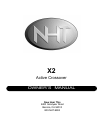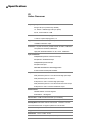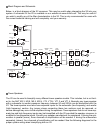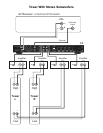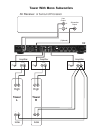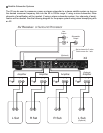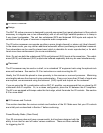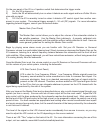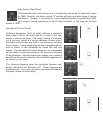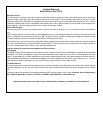
High Pass Filter Switch (Rear Panel)
The High Pass Filter determines the range of frequencies that the main speakers
("satellites") will reproduce. For example, a high pass setting of 80Hz means that the
main speakers receive a signal containing only frequencies above 80Hz. The 3-positon
High Pass Filter is selectable between 50Hz, 80Hz, and 110Hz to accommodate a vari-
ety of speaker sizes.
Set the High Pass Filter to a frequency above the rated low frequency limit of the main speakers. For
example, if your speakers have a rated low frequency response of 40Hz, use the 50Hz high-pass set-
ting. If your speakers have a rated low frequency response of 90Hz, use the 110Hz high-pass setting.
Check the owner's manual for their rated low frequency response.
Low Pass Filter Control (Front Panel)
The continuously variable Low Pass Filter determines the range of frequencies produced
by the subwoofer. For example, a low pass setting of 100Hz means that the subwoofer
reproduces only frequencies below 100Hz. The LFE input is not affected by this control.
Adjust the Low Pass Filter to approximately the same setting as the High Pass Filter as a starting point.
Adjust the Low Pass Filter in small increments up or down until the blend between the subwoofer and
your main speakers is seamless and the subwoofer does not call attention to itself. Music featuring
male vocals, cello and acoustic bass, bass guitar and certain wind instruments (like saxophone and
trombone) is useful for setting the low pass frequency.
Phase Controls (Front Panel)
The Subwoofer Phase switch and continuously variable knob change the phase of the
subwoofer output anywhere from 0° to 270° relative to the high pass output. Proper
subwoofer phase is important to achieve smooth bass response. An improper phase
setting causes dips in the frequency response of the combined subwoofer/satellite
system at the listening position. The result of these dips is low frequency production
that is very deficient at certain frequencies and a lack of seamless integration between the satellites
and subwoofer.
The optimal phase setting will vary depending on room conditions and placement. While fine tuning
the phase setting, have a familiar stereo CD available. You should listen to the same song while alter-
nating phase settings. Find the best setting while sitting at the primary listening position.
The initial settings described in Section 7 provide a good starting point for your system. However,
experimentation is the key to getting the best possible sound quality out of the system. Begin by set-
ting the phase knob at 0°, alternating the switch position between 0° and 180°. From the listening posi-
tion, choose the switch position that yields the most bass output and leave the switch in that position.
Then use the knob to fine-tune the phase setting. Slowly twist the knob, listening for the point at which
the bass at the listening position is the loudest. Small changes in phase generally produce subtle
changes in bass output. You may have to adjust the knob now and again over a period of a few weeks
to find the best setting for your listening room.



